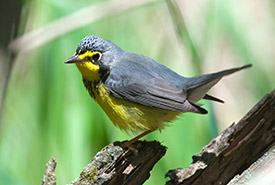Welcoming our summer visitors

Canada warbler (Photo by Gerald Deboer)
Spring at the cottage is so exciting. I have many clear memories of those first steps out of the car each year after the lake ice has broken up…The scent of trees coming back to life, humidity from breezes blowing across the waves, the earth and its ferns and mosses emerging from below their melting blanket of snow. It is a torrent of promise. And while opening shutters, sweeping decks and hauling wood, we always keep an ear open for the official first signs of spring: our feathered friends returning for the summer.
Most of us think of the hundreds of migratory bird species that breed in Canada as being Canadians who, perhaps wisely, fly south to avoid the winter storms. However, the truth is that our migrants spend more of their life in their winter grounds than up north. Many are only in Canada for four or five months of the year. Their gorgeous summer plumage is not their normal attire, but their best party clothes, carefully prepared to show them at their finest for their brief breeding period. Once breeding is over for another year, they cast it off in favour of the more serviceable avian equivalents of overalls and work boots.
Rather than being Canadians who flee the cold winters, they are more like southern residents who make the long trek north each year for a short visit to escape the masses of other southern species that are taking up all the prime southern real estate for their own breeding activities. Many of us, also immigrants or children of immigrants to this country, can surely relate. And Canada can be most welcoming to both human and avian visitors.
Each spring, we wait eagerly for the first songs of so many warblers — Canada, magnolia, chestnut-sided, Blackburnian, and more — to grace our forests. My teenage daughter, Wren, snoozes in her bunk as I kayak around the lake, listening for her namesakes in the forests, marshes and sedge meadows around its edges. “You can remember the winter wren’s song, because it is so long ― it lasts as long as a Canadian winter!” I mention to a couple in a canoe. Their eyes light up, and they nod vigorously. They know just what I mean.
Urban habitats are important for some of our summer visitors, such as threatened chimney swifts. But many other species are much more comfortable in natural surroundings. This makes cottage country great for watching a variety of interesting species. Depending on where you are, you might see bald eagles, ospreys or black terns diving into lakes and deep ponds; black-throated green or Blackburnian warblers in coniferous forests; and Canada warblers and red-headed woodpeckers in deciduous thickets. The relatively remote landscapes that attract cottagers also attract many breeding birds not found in more human-altered habitats.
Our migrants have flown hundreds or thousands of kilometres to find one thing: space. But they need more than just room for their own nests; they need room to forage, raise young, hang out with members of their own species and hide from predators. They need the right mix of vegetation, water and shelter. It’s amazing to think that for many migrants that spend their summers in Canada, they also need to be able to find suitable habitat in far more tropical climes. To keep them coming back, we need to protect their habitats across their winter range, summer range and migratory pathways.
Grasslands and shrublands are among the least protected yet most disturbed ecosystems world-wide. Conversely, boreal forest offers us one of our last opportunities to protect a relatively intact and natural ecosystem. Almost all habitats are at risk of human development and need our protection. Like cottagers, our migrant birds have a couple of homes, and we need to protect these homes and the links in between to make sure that once they leave our backyards, they can come back.
This article originally appeared in The Cottager magazine and is reposted with permission.

